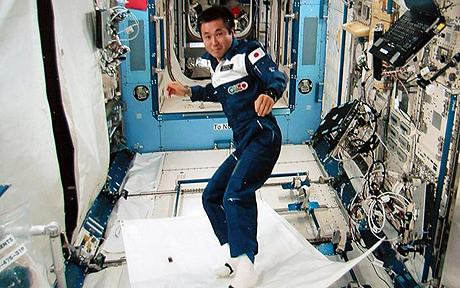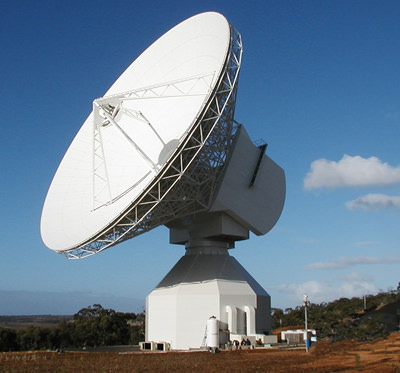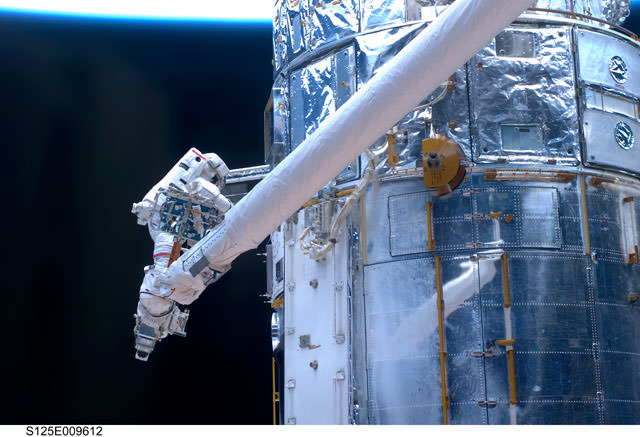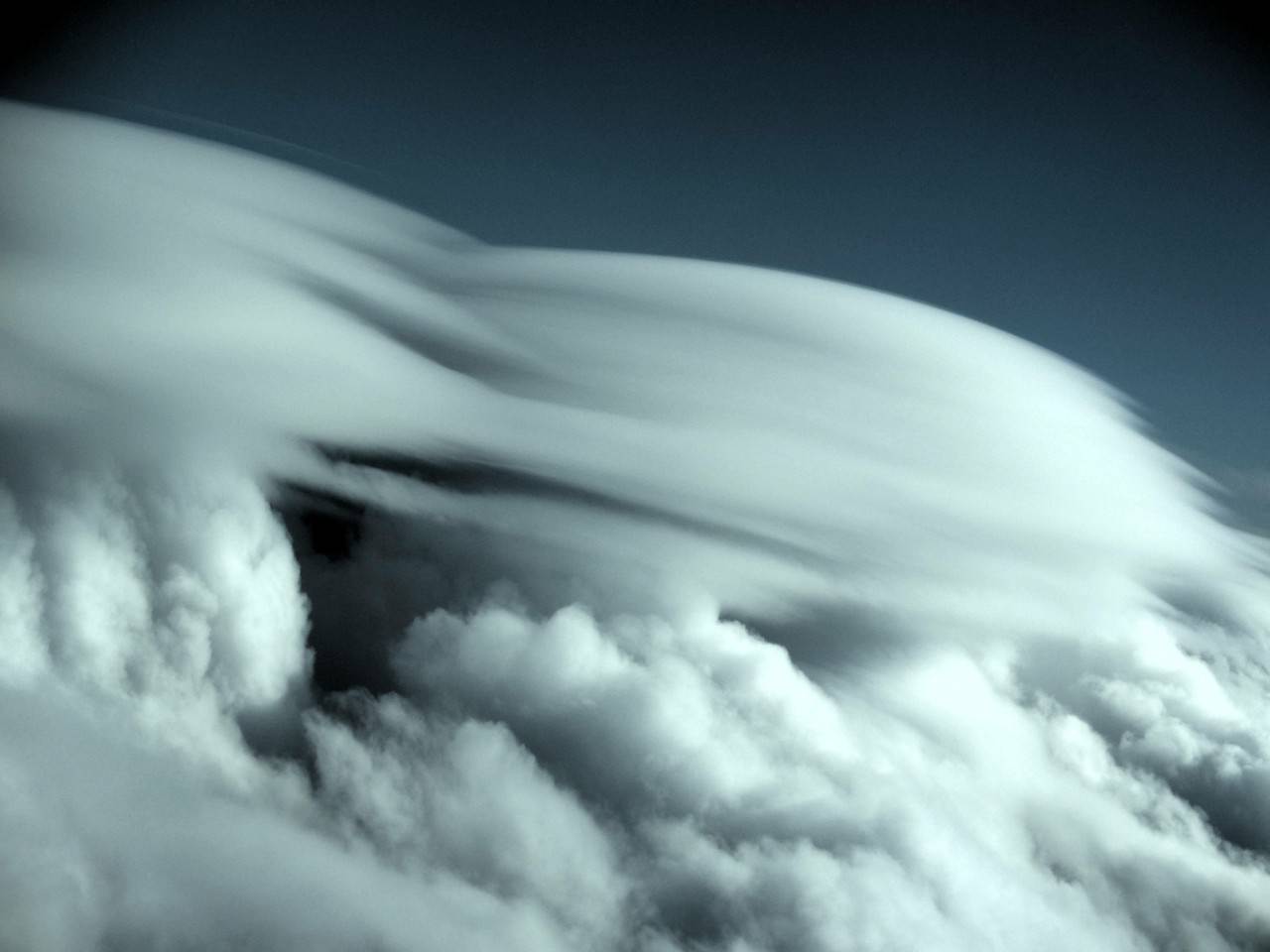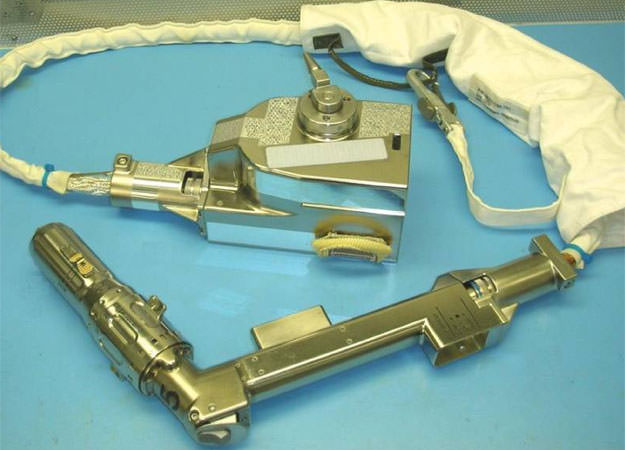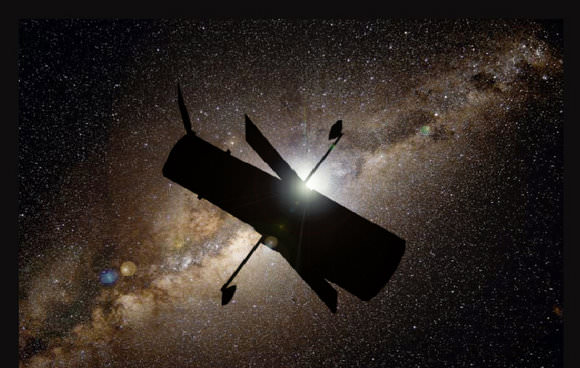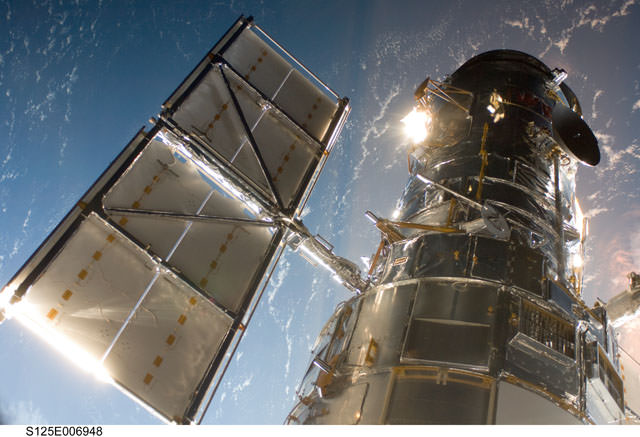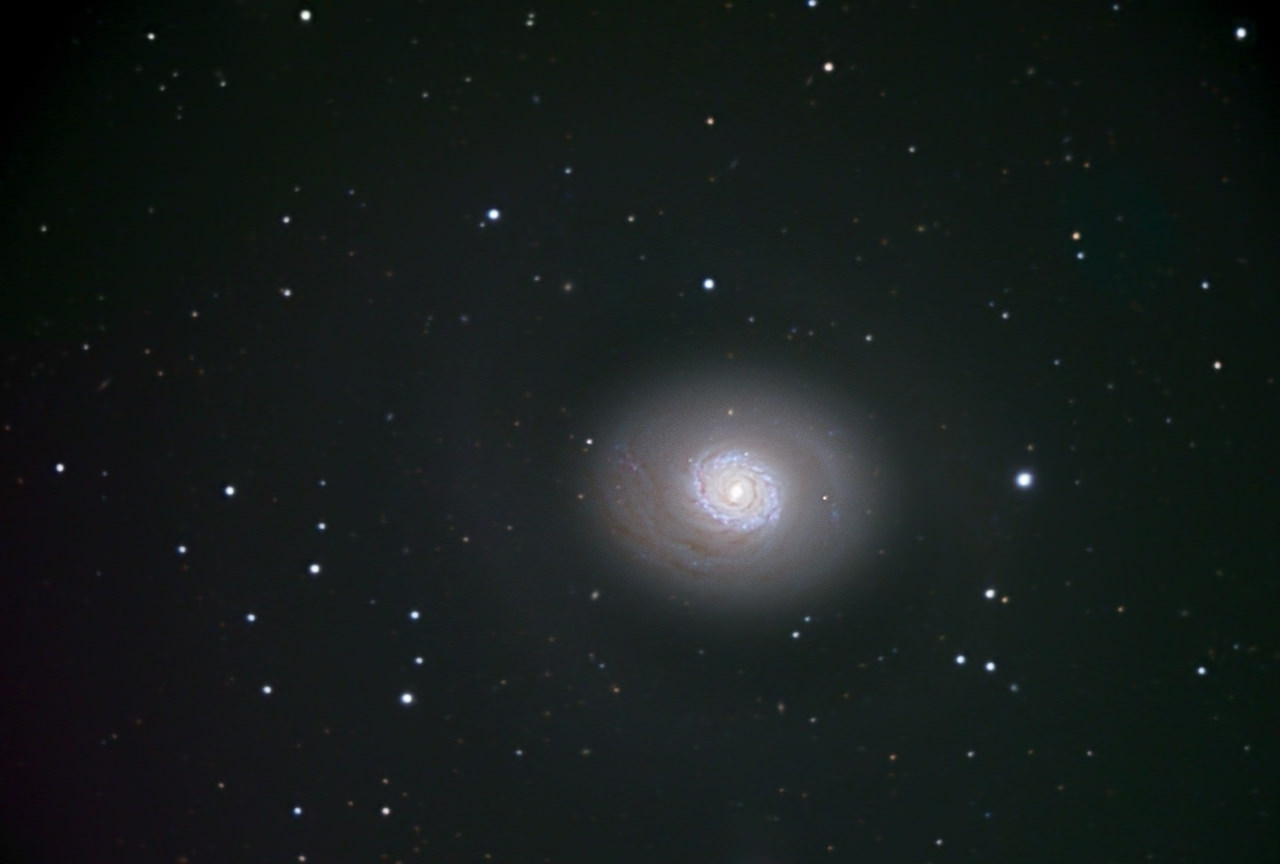After five spacewalks on consecutive days to bring new life to the Hubble Space Telescope, astronauts on space shuttle Atlantis said goodbye to the venerable observatory, releasing it back to its orbital home. Watching it float out of the cargo bay was a bittersweet moment for everyone involved with the mission, and space enthusiasts, too, as even though Hubble is in great shape and now set to look out farther than ever before, this is that last time humans will visit, touch and care for the world’s most famous telescope. “It’s a sad moment but a great moment, because we put the Hubble in the best posture and and best performance in can be in,” said Jon Morse, NASA Astrophysics division director.
Continue reading “Astronauts Release Hubble — Watch the Video”
Flying Carpets in Space: Yes. Folding Laundry: No
[/caption]
Astronauts in orbit have said it time and time again: some things are easier in the microgravity environment in space, other things are harder. Japanese astronaut Koichi Wakata, current resident of the International Space Station recently gave a video demonstration of a few odd tasks in space, showing how simple, everyday jobs here on Earth, such as folding laundry and using eye drops, can become difficult in space. But he also proved how one “impossible” action for us landlubbers is fairly simple to do on board the ISS. He soared on a magic carpet.
Wakata filmed 16 different tasks in space as part of a series of zero-gravity challenges submitted by the public.
Albeit, he couldn’t use just any carpet; it had to be magic. Or in this case, a carpet with a little rigidity worked the best, and he had one more secret to his success: adhesive tape (not sure if it was duct tape). Here’s the video clip of posted by the Japan Aerospace Exploration Agency (Jaxa).
Wakata is shown gliding smoothly, after a fashion, through a cabin of the International Space Station, as if snowboarding.
“I flew on this magic carpet by using adhesive tape so that the soles of my feet stayed on it,” the 45-year-old astronaut said. The tasks were selected from ideas sent to the space agency by hundreds of members of the Japanese public, from nursery school pupils to a 90-year-old man. Wakata performed the tasks in the Japanese laboratory Kibo (Hope) of the ISS on May 15. He also filmed a series of other tasks in April, including push-ups.
He handled the awkward task of folding laundry in microgravity, struggling with a shirt and then, for added difficulty, the floating arms and legs of a blue space overall. Finally, a bungee cord was necessary to keep the uncooperative overall from unfolding.
Tackling another challenge, Wakata showed how to use eye drops in zero gravity, squeezing out a tiny ball of liquid and letting it perch at the tip of the container before carefully bringing it to his eye.
Source: The Telegraph
Cosmologists Improve on Standard Candles Measurement
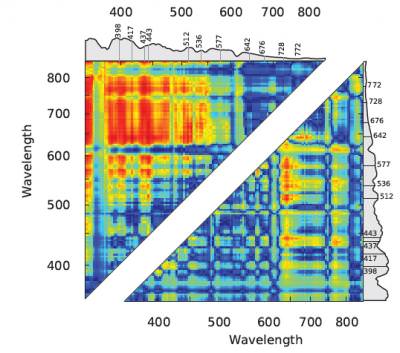
[/caption]
Cosmologists have found a new and quicker technique that establishes the intrinsic brightness of Type Ia supernovae more accurately than ever before. These exploding stars are the best standard candles for measuring cosmic distances and are the tools that made the discovery of dark energy possible. An international team has found a way to do the job of measuring stellar distances in just a single night as opposed to months of observations by simply measuring the ratio of the flux (visible power, or brightness) between two specific regions in the spectrum of a Type Ia supernova. With this new method, a supernova’s distance can be determined to better than 6 percent uncertainty.
Using classic methods, which are based on a supernova’s color and the shape of its light curve – the time it takes to reach maximum brightness and then fade away – the distance to Type Ia supernovae can be measured with a typical uncertainty of 8 to 10 percent. But obtaining a light curve takes up to two months of high-precision observations. The new method provides better correction with a single night’s full spectrum, which can be scheduled based on a much less precise light curve.
Members of the international Nearby Supernova Factory (SNfactory), a collaboration among the U.S. Department of Energy’s Lawrence Berkeley National Laboratory, a consortium of French laboratories, and Yale University, searched the spectra of 58 Type Ia supernovae in the SNfactory’s dataset and found the key spectroscopic ratio.
The new brightness-ratio correction appears to hold no matter what the supernova’s age or metallicity (mix of elements), its type of host galaxy, or how much it has been dimmed by intervening dust.
Team member Stephen Bailey from the Laboratory of Nuclear and High-Energy Physics (LPNHE) in Paris, France, says that the SNfactory’s library of high-quality spectra is what made his successful results possible. “Every supernova image the SNfactory takes is a full spectrum,” he says. “Our dataset is by far the world’s largest collection of excellent Type Ia time series, totaling some 2,500 spectra.”
The most accurate standardization factor Bailey found was the ratio between the 642-nanometer wavelength, in the red-orange part of the spectrum, and the 443-nanometer wavelength, in the blue-purple part of the spectrum. In his analysis he made no assumptions about the possible physical significance of the spectral features. Nevertheless he turned up multiple brightness ratios that were able to improve standardization over current methods applied to the same supernovae.
SNfactory member Rollin Thomas of Berkeley Lab’s Computational Research Division, who analyzes the physics of supernovae, says, “While the luminosity of a Type Ia supernova indeed depends on its physical features, it also depends on intervening dust. The 642/443 ratio somehow aligns those two factors, and it’s not the only ratio that does. It’s as if the supernova were telling us how to measure it.”
The Nearby Supernova Factory describes the discovery of the new standardization technique in an article in the forthcoming issue of the journal Astronomy & Astrophysics, and the abstract is available online.
Source: Berkeley
Herschel Phones Home — Literally
[/caption]
For the first time in spaceflight history, a satellite has used mobile phone technology to radio back to Earth. The Herschel spacecraft – which launched on May 14, called home two days later using the same technology used in GSM mobile phone networks to send test data to ESA’s deep space tracking station. “Herschel’s 1.5-Mbps test transmission – roughly the same data rate provided by a home broadband Internet connection – was picked up at ESA’s ESTRACK station at New Norcia, Australia, on Saturday, as the satellite was travelling some 280 000 km from Earth,” said John Dodsworth, the Herschel-Planck Flight Operations Director.
This marks the first-ever use of Gaussian Minimum Shift Keying (GMSK) modulation in space. GMSK is commonly used in Global System for mobile Communication (GSM) mobile phone networks due to its very efficient use of bandwidth and power.
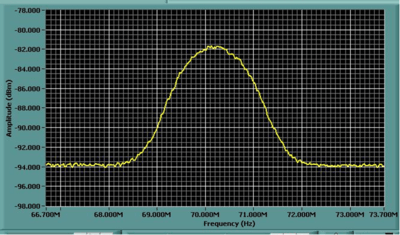
In a typical GSM mobile phone network, the same technology transmits data at a somewhat lower speed. The Planck spacecraft that was launched along with Herschel also uses GMSK technology, and its transmission capability will be tested later during the satellite’s commissioning phase.
During their missions, the GMSK-based radio links will be used by both spacecraft to transfer data gathered by their scientific instruments and on-board subsystems, providing information on flight status and overall health.
The development was driven by the need to use bandwidth more efficiently in view of the growing number of ESA missions that require X-band communications via the Agency’s deep space ground stations.
The GSM standard is the most popular modulation standard for mobile phone networks in the world. According to the GSM Association, terrestrial GSM networks now cover more than 80% of the world’s population in more than 212 countries and territories – and will soon extend 1.5 million kms further to L2, Herschel and Plank’s final orbital destination.
Source: ESA
‘Tremendous Adventure’ Gives Hubble New Life
[/caption]
Almost like Benjamin Button, the Hubble Space Telescope is now more vigorous and capable than with its original complement of instruments. “This is a tremendous adventure we’ve been on,” said astronaut John Grunsfeld at the end of Monday’s very successful EVA to repair and refurbish the famous space telescope. “This has been a very challenging mission. Hubble isn’t just a satellite, but it’s about humanity’s quest for knowledge.”
Grunsfeld and Drew Feustel installed a set of the observatory’s batteries, replaced a fine-guidance sensor that helps keep the telescope’s gaze precisely fixed on astronomical targets, and also replaced three thermal blankets protecting Hubble’s electronics.
“With today’s EVA Hubble is returned to flagship status with a full complement of instrument and tools for astronomers to use for the next several years,” saidJon Morse, Astrophyscis Division Director as NASA. “It is bittersweet to know this is our last visit to Hubble, but we have a saying in the science mission directorate: science never sleeps. So our work is just beginning. We have literally thousands of astronomers waiting to use Hubble, chomping at the bit to get their data.”
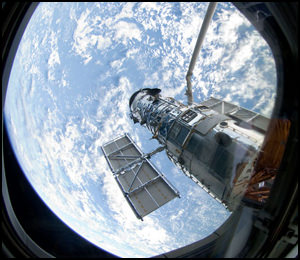
Monday’s 7 hour and 2 minute-long spacewalk marked the end of the five scheduled spacewalks for the STS-125 servicing mission. However the spacewalking team of Mike Massimino and Mike Good will be ready to go outside if any issues crop up Tuesday morning when all the systems are checked out before Hubble is released by the shuttle crew. Mission managers hope to have Atlantis back on the ground by Friday.
Earlier spacewalks overcame stubborn bolts and problematic tools, but all the mission objectives were achieved, much to the delight of everyone at NASA.
“This must be what it’s like to win the superbowl,” said Preston Burch, Hubble Program Manager. “As those of you who have followed us the past five days, working in space is challenging and there is a fine line between things that look easy and things that are impossible. The crew just never gave up.”
Lead flight director, Tony Ceccacci reminded everyone at a press conference following the EVA that Monday’s spacewalk was the last planned EVA out of the shuttle airlock. “It was both a very happy day and a sad day. We looked at each other and knew that was the last planned EVA out of the shuttle airlock. We’ve been working on this for over 2 ½ years, and we looked at each other and said, ‘wow this is really over.'”
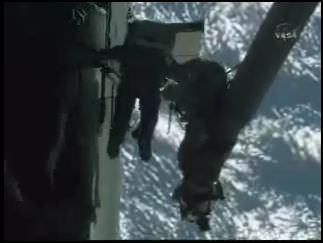
The only glitch in the otherwise smooth EVA came at the very end when Grunsfeld – a self-proclaimed “Hubble Hugger” inadvertently bumped into one of the observatory’s two low-gain antennas with his foot, breaking off a small end cap. Grunsfeld felt terrible about the accident. “OK. I’m sick,” he said. However, the antenna still worked normally, mission control radioed up to him.
Grusnfeld and Feustel placed a protective cover over the cone-shaped device for added insulation before ending the spacewalk.
“Sorry, Mr. Hubble,” Grunsfeld said as he headed back to Atlantis’ airlock. “Have a good voyage.”
“Consider it a goodbye kiss, John,” Massimino radioed from inside the shuttle.
As Grunsfeld prepared to head back inside the shuttle he asked to say a few words.
“On this mission, we tried some things that some people said were impossible,” Grunsfeld said later. “We’ve achieved that, and we wish Hubble the very best.”
A replay of highlights from the 5th spacewalk is available.
First Observations of Biological Particles in High-Altitude Clouds
[/caption]
A team of atmospheric chemists has moved closer to what’s considered the “holy grail” of climate change science: the first-ever direct detections of biological particles within ice clouds. Ice in Clouds Experiment – Layer Clouds (ICE-L) team mounted a mass spectrometer onto a C-130 aircraft and made a series of high-speed flights through a type of cloud known as a wave cloud. Analysis of the ice crystals revealed that the particles that started their growth were made up almost entirely of either dust or biological material such as bacteria, fungal spores and plant material. While it has long been known that microorganisms become airborne and travel great distances, this study is the first to yield direct data on how they work to influence cloud formation.
The team, led by Kimberly Prather and Kerri Pratt of the University of California at San Diego, Scripps Institution of Oceanography, performed in-situ measurements of cloud ice crystal residues and found that half were mineral dust and about a third were made up of inorganic ions mixed with nitrogen, phosphorus and carbon–the signature elements of biological matter.
The second-by-second speed of the analysis allowed the researchers to make distinctions between water droplets and ice particles. Ice nuclei are rarer than droplet nuclei.
The team demonstrated that both dust and biological material indeed form the nuclei of these ice particles, something that previously could only be simulated in laboratory experiments.
“This has really been kind of a holy grail measurement for us,” said Prather.
“Understanding which particles form ice nuclei, and which have extremely low concentrations and are inherently difficult to measure, means you can begin to understand processes that result in precipitation. Any new piece of information you can get is critical.”
The findings suggest that the biological particles that get swept up in dust storms help to induce the formation of cloud ice, and that their region of origin makes a difference. Evidence is increasingly suggesting that dust transported from Asia could be influencing precipitation in North America, for example.
Researchers hope to use the ICE-L data to design future studies timed to events when such particles may play a bigger role in triggering rain or snowfall.
“If we understand the sources of the particles that nucleate clouds, and their relative abundance, we can determine their impact on climate,” said Pratt, lead author of the paper.
The effects of tiny airborne particles called aerosols on cloud formation have been some of the most difficult aspects of weather and climate for scientists to understand.
In climate change science, which derives many of its projections from computer simulations of climate phenomena, the interactions between aerosols and clouds represent what scientists consider the greatest uncertainty in modeling predictions for the future.
“By sampling clouds in real time from an aircraft, these investigators were able to get information about ice particles in clouds at an unprecedented level of detail,” said Anne-Marie Schmoltner of NSF’s Division of Atmospheric Sciences, which funded the research.
Source: EurekAlert
Super-Tools Essential to Hubble Mission Success
[/caption]
Astronauts from the STS-125 mission have now successfully completed all the EVAs for the Hubble Servicing Mission, accomplishing all the mission goals. Undoubtedly, the special tools the astronauts were essential to the success of the mission. In fact, at the end of today’s fifth spacewalk, astronaut John Grunsfeld called the mission “a tour de force of tools and human ingenuity.” To have any chance of completing the wide variety of tasks for this mission, NASA had to develop more than 100 new tools for removing, installing and repairing components on Hubble. “The biggest challenge for us in designing and developing tools for astronauts is to make it easy for them to use in their suit,” said Jill McGuire, manger of the CATs team (Crew Aids and Tools) for the HST mission. “EVA time is at a premium. So, any tool that we develop we develop it in order to optimize the time we have up there and make it as easy and simple for the astronauts to use.” The team built a variety of tools, from power tools to different hand tools that the astronauts used. Here’s a look at some of these super-tools:
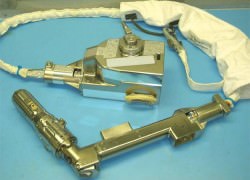
“I like all the tools, but the one I’ll probably be using the most is the Mini-Power Tool,” said STS-125 astronaut Mike Massimino before the flight. “It’s a little drill and is a unique tool that I think is going to be used in space for a long time. So, I’m very glad we’re going to be the first ones to use it and I bet you’re going to see a lot of space crews using it for many years on new space ships. This is going to be a pretty cool tool.”
NASA has long used a cordless drill called the Pistol Grip Tool, but needed a faster tool with less torque than the PGT, and Cassisdy likened the mini power tool to what Indy pit crews used to rapidly change bolts.
The mini power tool spins at 210 revolutions per minute, as opposed to the PGT’s 15.
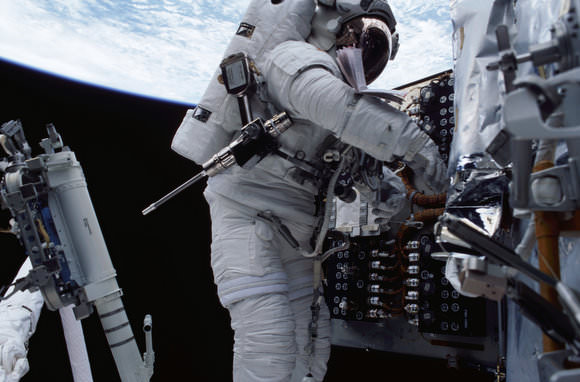
During the spacewalks, however, the astronauts did have to re-set the power tool’s torque settings to loosen some extremely tight bolts.
Some of these components, like the Space Telescope Imaging Spectrograph (STIS) were never designed for astronauts to fix on orbit. The instrument failed in 2004, and the problem was traced to the power supply. Justin Cassidy, the lead systems engineer for CATS team, compared the work astronauts would have to do on orbit to opening up a computer and replacing a board while wearing thick gloves on their hands and a fishbowl on their head.
“To actually open up an instrument and pull a board had never been thought of nor conceived that we would want to do that and therefore the interfaces were not very friendly to an astronaut,” said Cassidy.
In fact, there were 111 tiny screws that needed to be removed from the instrument in order to gain access to the board. Mike Massimino completed the STIS repair with the ingenious “fastener capture plate.”
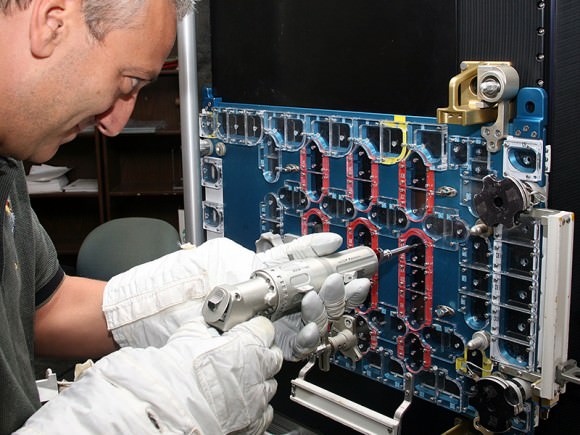
“The beauty of the fastener capture plate is, it does capture all the fasteners but it’s got a clear window,” said Cassidy. “And that clear window enables the astronaut, when he takes that power tool, he can actually see the little tiny bit going into the little tiny fastener. So, we have not blocked any of his visibility, yet when he takes that fastener out it won’t come out the little hole that the tool past through.”
It took 4-5 years to develop the mini power tool and the capture plate.
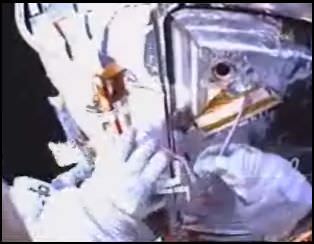
In today’s spacewalk, John Grunsfeld used a special tool to remove old insulation from the telescope so that new protective thermal insulation could be installed. The insulation protects the equipment bays on HST.
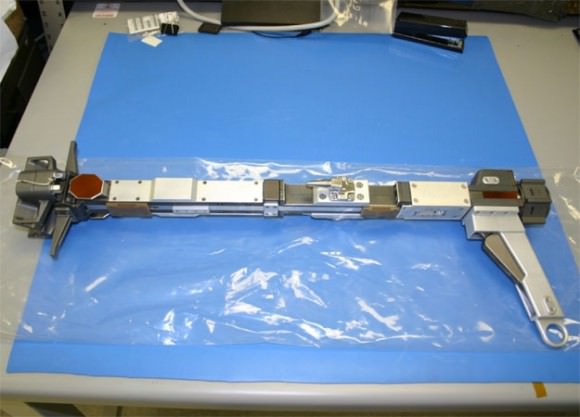
In order to replace the gyroscopes, or rate sensor units, which are located inside the Hubble Space Telescope and hard to reach while wearing a large spacesuit, engineers had to develop a tool that would work like an extension to an astronaut’s arm. Here is the Rate Sensing Units Changeout Tool, a crew member is able to reach inside the telescope without entering it, and capture and restrain a sensor unit by pulling a trigger. The tool is able to withstand temperatures ranging from -74 degrees F to 189 degrees F.
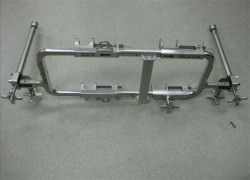
This Battery Extraction Tool allows an astronaut “grab” the batteries on Hubble, and exert additional force to remove it. This tool is capable of exerting several hundred pounds of exertion force.
“One could think you go to the hardware store and actually pick out a tool and use that in space,” said Cassidy. “The space environment is very harsh. It’s very hot, very cold, and it’s also in a vacuum and most tools, power tools for example that you pick up from Home Depot just would not survive in the environment of space.
Here are just a few things the CATs team has to consider when developing a new tool”
• The tight quarters the astronaut would have to work in with the tool.
• The brief amount of time an astronaut has to take out each fastener to release the board.
• Temperature swings of 500 degrees from the heat of direct sunlight to frigid shade. Either extreme can make the metal innards of a power tool seize up instantly.
• What would happen to each of the 111 fasteners in weightlessness.
• How much the tools weigh.
• Whether the tools can withstand the vibrations of launch.
Sources: NASA, Discovery Space,
Poetry in Space: Final Pilgrims to the Hubble Space Telescope
[/caption]
As today’s final spacewalk of the Hubble Servicing Mission begins, it seems very fitting to share a poem written by my friend Stuart Atkinson. Stuart is a poet, a blogger, a member of Unmanned Spaceflight.com (which means he is a Photoshopper extraordinaire!) and a passionate promoter of space exploration. Stuart has written many touching poems previously about the Mars rovers, the Phoenix lander, the Kepler mission and many other missions, but this verse about the final human mission to the Hubble Space Telescope is priceless. See below for “The Final Pilgrims” and check out Stu’s website Cumbrian Skies for more great poetry, images and information.
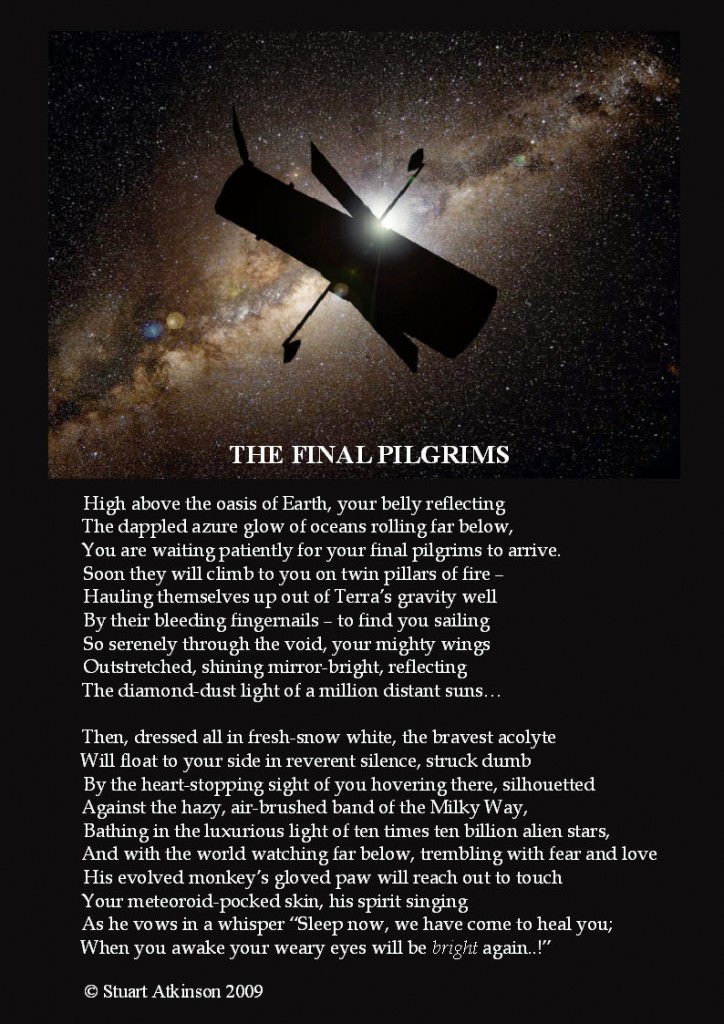
Thanks, Stu, for sharing your poem with Universe Today!
Hubble Servicing Mission 4 in Pictures, Part 1
[/caption]
The long-awaited Servicing Mission 4 for the Hubble Space Telescope has provided drama, nail-biting excitement, fist-pumping triumphs and ‘what else could go wrong now’ moments. But the best way to to describe the mission is to let the amazing images from the EVAs do the talking. Below are high-resolution images from NASA, highlighting the first three spacewalks.

The mission began with the picture-perfect, no-delay, long-awaited launch on May 11, 2009.
EVA #1

The first spacewalk of the mission, performed by astronauts John Grunsfeld and Drew Feustel lasted a little over 7 1/2 hours. They successfully installed the new Wide Field Camera 3 science instrument and a new Science Instrument Command and Data Handling Unit. Both WFC-3 and the SI C&DH passed their “aliveness” tests, which essentially means the devices powered on correctly. The WFC-3 also passed its functional test, meaning the capabilities of the instrument itself were tested. The SI C&DH unit has also received an initial OK on its functional test, pending final review of data sent down to the ground.
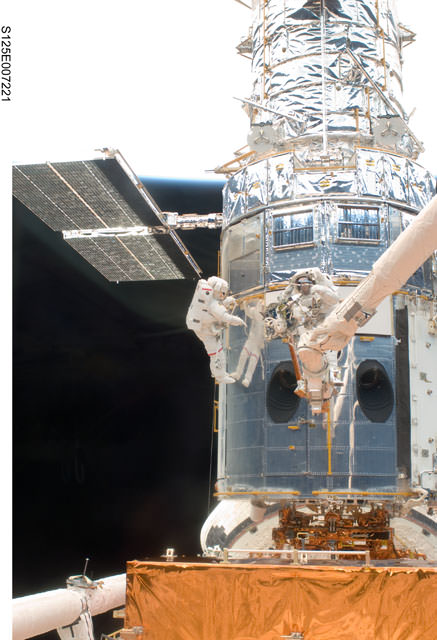
A stubborn bolt threatened to thwart one of the spacewalk’s main goals, replacing the venerable space telescope’s workhorse optical camera with a new and improved instrument. But after a fair amount of old fashioned elbow grease, the WFPC2 was able to be removed.

This close-up of Grunsfeld was taken by Drew Feustel, whose reflection is visible in Grunsfeld’s visor. Feustel is attached to the end of the shuttle Remote Manipulator System, or robotic arm. Grunsfeld was the free-floating astronaut for the EVA.

Here, Feustel, on the end of the shuttle’s robotic arm, carries the piano-sized WFPC3 to its new home inside Hubble.
EVA #2

The second EVA of the mission provided some challenges to astronauts Michael Good and Mike Massimino. However, they achieved all the objectives for this spacewalk, it just took them awhile — 7 hours and 56 minutes. They installed three Rate Sensor Units (RSUs), with a pair of gyros in each, and the first of two new battery module units.

Good and Massimino were not able to get one of the three prime RSUs into its slot but were able to install a spare, giving Hubble the new gyros it needed. The gyros are used to change the orientation of the telescope and keep it fixed on a particular astronomical target during observations.

The spacewalkers also removed one of the original battery modules from Bay 2 of the telescope and replaced it with a new unit. The batteries provide power to the telescope when Hubble passes into Earth’s shadow and its solar arrays are not exposed to the sun. Ground controllers at Goddard’s Space Telescope Operations Control Center confirmed that all six gyroscopes and the new battery passed preliminary tests.
EVA #3

The third EVA of the mission went like clockwork as Grunsfeld and Feustel teamed up again. They removed the Corrective Optics Space Telescope Axial Replacement and installed in its place the new Cosmic Origins Spectrograph. They also completed an unprecedented repair of the Advanced Camera for Surveys replacing an electronic card and installed a new electronics box and cable.

To do the repairs on ACS, Grunsfeld removed 32 screws from an access panel to replace the camera’s four circuit boards and install a new power supply. The two astronauts used specially designed tools to do a job that was never intended to be done on orbit. But they did it, and with efficiency.
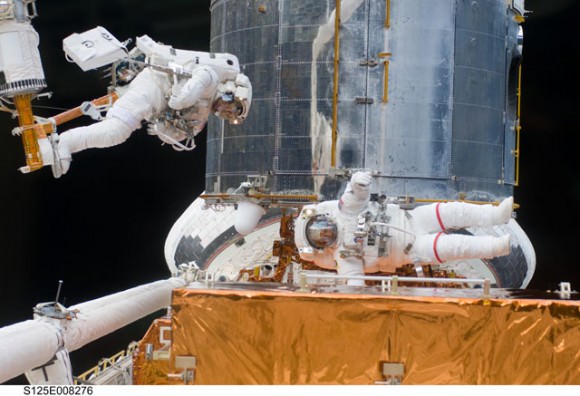
Engineers at Goddard have already performed “aliveness” tests on both COS and ACS to verify they have electrical power. However while a functional test of the ACS indicated success in reviving the instrument’s heavily used wide-field channel, officials said early Sunday that it appears the repairs failed to resolve power problem with the camera’s stricken high-resolution channel and it appears “down for the count.”
We’ll keep you posted on any developments with ACS, and provide more high-resolution images from the remainder of the mission soon!
For more images from the mission, or to download higher resolution versions of the pictures here, visit NASA’s Human Spaceflight gallery.
M94 – The “Cat’s Eye” Galaxy by Roth Ritter
[/caption]
About 13 million light-years away in the constellations Canes Venatici, there’s a cloud. No, it’s not the same clouds that most of us have been experiencing lately – but a cluster of galaxies which appear form a single large cloud-like structure. The one we’re focusing on is Canes Venatici I, just a small section of the Virgo Supercluster and just moving along with the expansion of the Universe. In it we see a galaxy that stands out from the crowd for a very good reason… it has very little or no dark matter. It’s name? Messier 94.
When the very gifted Pierre Mechain discovered this galaxy on March 22, 1781, it took two days before Charles Messier had the chance to confirm his observation and catalog it as object 94. From Messier’s notes: “`Nebula without star, above the Heart of Charles [alpha Canum Venaticorum], on the parallel of the star no. 8, of sixth magnitude of the Hunting Dogs [Canes Venatici], according to Flamsteed: In the center it is brilliant and the nebulosity [is] a bit diffuse. It resembles the nebula which is below Lepus, No. 79; but this one is more beautiful and brighter: M. Mechain has discovered this one on March 22, 1781. (diam. 2.5′)”.
While most observers and some reference guides refer to M94 as a barred spiral galaxy (Sb), the notable feature of all is a dual ring structure – evidence of a low-ionization nuclear emission-line region (LINER) galactic nucleus. The inner core is a starburst ring, where many stars form rapidly and undergo supernovae at an astonishing rate. These starbursts may also be accompanied by the formation of galactic jets as matter falls into the central black hole forming a resonance pattern. Says C. Munoz-Tunon: “The bulge and the inner bar drive disk gas motion, causing inward movements outside the H II ring and outward just inside, thereby accumulating material to trigger star formation on the ring. In the central part the bar drives the gas toward the center, which explains the substantial amount of gas in the nucleus in spite of the presence of a fossil starburst. The peculiar motions reported in the literature in reference to the ionized gas of the H II ring can be understood as infalling gas encountering the shock waves generated by the starburst knots on the H II ring and being raised above the galaxy disk. The scenario of star formation propagating from the nucleus outward used to explain the apparent expanding motion of the HI ring is not fully supported, in light of a comparison of the location of the HI ring with that of the FUV ring. The FUV ring peaks at about 45″-48″, which might point to an inward-propagating star formation scenario.”
But, the point is arguable. According to the work of John Kormendy and Robert Kennicutt, it’s possible that what we’re seeing is simply an illusion of starburst caused by our viewing angle. “The Universe is in transition. At early times, galactic evolution was dominated by hierarchical clustering and merging, processes that are violent and rapid. In the far future, evolution will mostly be secular the slow rearrangement of energy and mass that results from interactions involving collective phenomena such as bars, oval disks, spiral structure, and triaxial dark halos. Both processes are important now. This review discusses internal secular evolution, concentrating on one important consequence, the buildup of dense central components in disk galaxies that look like classical, merger-built bulges but that were made slowly out of disk gas. We call these pseudobulges.”
Regardless of what caused the dual ring structure and declining rotation curves – the true answer is still elusive. Oddly enough it was what was proposed in 2008 which made Messier 94 even more mysterious… the lack of dark matter.
So, why should dark matter “matter”? That’s easy. We know its gravitational effects on visible matter and thereby we can explain the flat rotation curves of spiral galaxies, not to mention dark matter has a central role in galaxy structure formation and galaxy evolution. We owe these findings to Fritz Zwicky who told us that a a high mass-to-light ratio indicates the presence of dark matter in galaxies – just as he taught us that dark matter plays a role in galaxy clusters as well. Dr. Zwicky’s line of thinking was radical for the time… But is there still room for radical thinking? Why not?
According to the work of Joanna Jalocha, Lukasz Bratek and Marek Kutschera, ordinary luminous stars and gas account for all the material in M94 – with no room for dark matter. “The comparison of mass functions and rotation laws at the end of the previous section, illustrates the fact that the models with flattened mass distributions are more efficient than the commonly used models assuming spherical halo. The former are better in accounting both for high rotational velocities as well as for low scale structure of rotation curves and with noticeably less amount of matter than the latter (the relation between rotation and mass distribution in the disk model is very sensitive for gradients of a rotation curve). The use of the disk model is justified for galaxies with rotation curves violating the sphericity condition. This is necessary (although not sufficient) condition for a spherical mass distribution. Rotation of the spiral galaxy NGC 4736 can be fully understood in the framework of Newtonian physics. We have found a mass distribution in the galaxy that agrees perfectly with its high-resolution rotation curve, agrees with the I-band luminosity distribution giving low mass-to-light ratio of 1.2 in this band at total mass of 3.43 × 1010M, and is consistent with the amount of HI observed in the remote parts of the galaxy, leaving not much room (if any) for dark matter. Remarkably, we have achieved this consistency without invoking the hypothesis of a massive dark halo nor using modified gravities.
There exist a class of spiral galaxies, similar to NGC 4736, that are not dominated by spherical mass distribution at larger radii. Most importantly, in this region rotation curves should be reconstructed accurately in order not to overestimate the mass distribution. For a given rotation curve it can be easily determined whether or not a spherical halo may be allowed at large radii by examining the Keplerian mass function corresponding to the rotation curve (the so called sphericity test). By using complementary information of mass distribution, independent of rotation curve, we overcame the cutoff problem for the disk model, that for a given rotation curve, a mass distribution could not be found uniquely as it was dependent on the arbitrary extrapolation of the rotation curve.”
More explanation? Then step into MOND – Modified Newtonian dynamics where a modification of Newton’s Second Law of Dynamics (F = ma) is used to explain the galaxy rotation problem. It simply states that acceleration is not linearly proportional to force at low values. But will it work here? Who knows? Says Jacob Bekenstein: “The modified newtonian dynamics (MOND) paradigm of Milgrom can boast of a number of successful predictions regarding galactic dynamics; these are made without the assumption that dark matter plays a significant role. MOND requires gravitation to depart from Newtonian theory in the extragalactic regime where dynamical accelerations are small. So far relativistic gravitation theories proposed to underpin MOND have either clashed with the post-Newtonian tests of general relativity, or failed to provide significant gravitational lensing, or violated hallowed principles by exhibiting superluminal scalar waves or an {a priori} vector field.”
So next time you’re out observing galaxies, have a look at the “Cat’s Eye” Galaxy. Even a small telescope will reveal its bright, controversial nucleus and wispy shape. And thanks to outstanding astrophotographers like Roth Ritter we’re allowed to see a whole lot more…
Our thanks go to Roth Ritter of Northern Galactic for sharing his incredible work!

